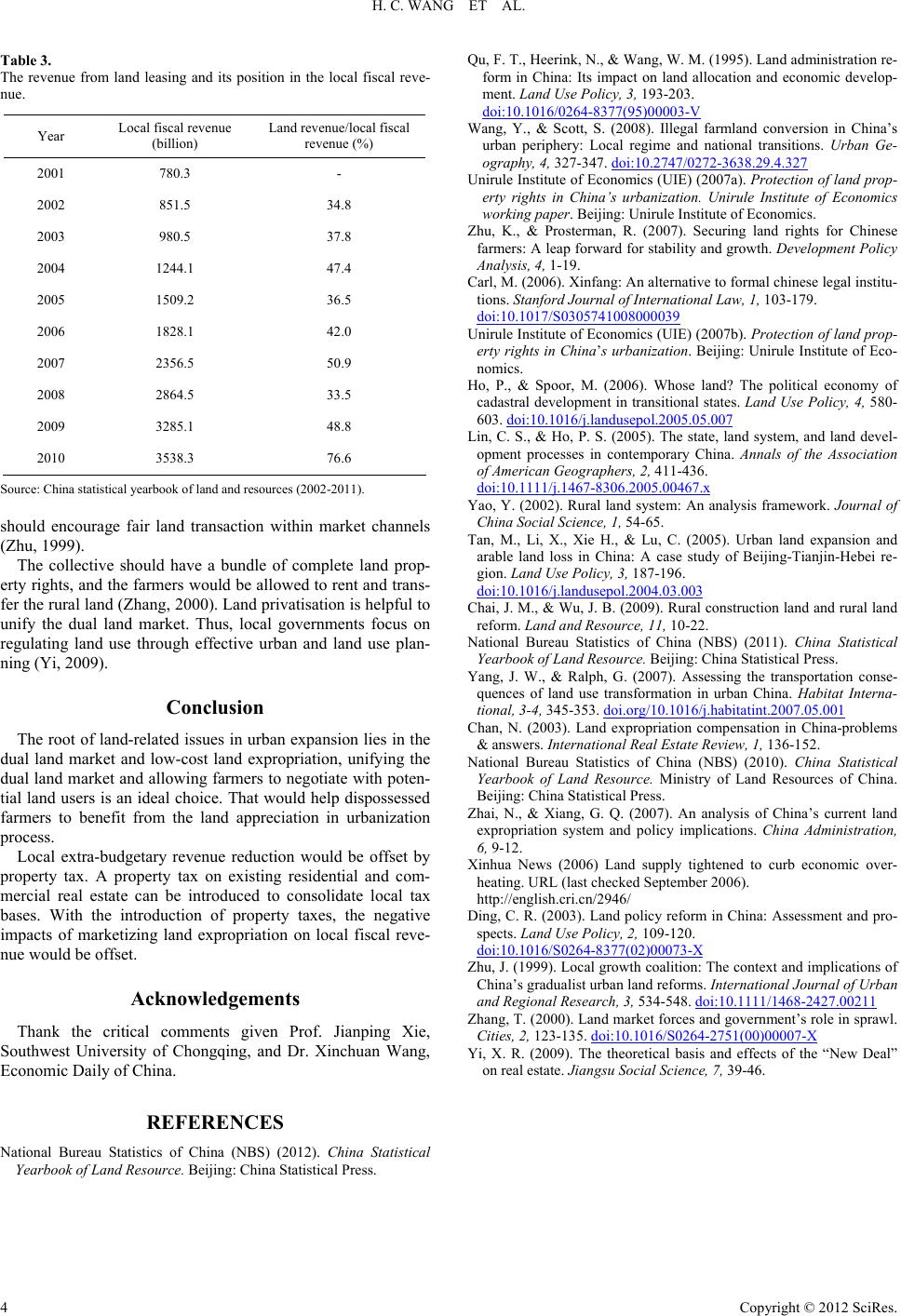
H. C. WANG ET AL.
Table 3.
The revenue from land leasing and its position in the local fiscal reve-
nue.
Year Local fiscal revenue
(billion) Land revenu e/local fisc al
revenue (%)
2001 780.3 -
2002 851.5 34.8
2003 980.5 37.8
2004 1244.1 47.4
2005 1509.2 36.5
2006 1828.1 42.0
2007 2356.5 50.9
2008 2864.5 33.5
2009 3285.1 48.8
2010 3538.3 76.6
Source: China statistical yearbook of land and resources (2002-2011).
should encourage fair land transaction within market channels
(Zhu, 1999).
The collective should have a bundle of complete land prop-
erty rights, and the farmers would be allowed to rent and trans-
fer the rural land (Zhang, 2000). Land privatisation is helpful to
unify the dual land market. Thus, local governments focus on
regulating land use through effective urban and land use plan-
ning (Yi, 2009).
Conclusion
The root of land-related issues in urban expansion lies in the
dual land market and low-cost land expropriation, unifying the
dual land market and allowing farmers to negotiate with poten-
tial land users is an ideal choice. That would help dispossessed
farmers to benefit from the land appreciation in urbanization
process.
Local extra-budgetary revenue reduction would be offset by
property tax. A property tax on existing residential and com-
mercial real estate can be introduced to consolidate local tax
bases. With the introduction of property taxes, the negative
impacts of marketizing land expropriation on local fiscal reve-
nue would be offset.
Acknowledgements
Thank the critical comments given Prof. Jianping Xie,
Southwest University of Chongqing, and Dr. Xinchuan Wang,
Economic Daily of China.
REFERENCES
National Bureau Statistics of China (NBS) (2012). China Statistical
Yearbook of Land Reso urc e. Beijing: China Statistical Press.
Qu, F. T., Heerink, N., & Wang, W. M. (1995). Land administration re-
form in China: Its impact on land allocation and economic develop-
ment. Land Use Policy, 3, 193-203.
doi:10.1016/0264-8377(95)00003-V
Wang, Y., & Scott, S. (2008). Illegal farmland conversion in China’s
urban periphery: Local regime and national transitions. Urban Ge-
ography, 4, 327-347. doi:10.2747/0272-3638.29.4.327
Unirule Institute of Economics (UIE) (2007a). Protection of land prop-
erty rights in China’s urbanization. Unirule Institute of Economics
working paper. Beijing: Unirule Institute of Eco nomics.
Zhu, K., & Prosterman, R. (2007). Securing land rights for Chinese
farmers: A leap forward for stability and growth. Development Policy
Analysis, 4, 1-19.
Carl, M. (2006). Xinfang: An alternative to formal chinese legal institu-
tions. Stanford Journal of International Law, 1, 103-179.
doi:10.1017/S0305741008000039
Unirule Institute of Economics (UIE) (2007b). Protection of land prop-
erty rights in China’s urbanization. Beijing: Unirule Institute of Eco-
nomics.
Ho, P., & Spoor, M. (2006). Whose land? The political economy of
cadastral development in transitional states. Land Use Policy, 4, 580-
603. doi:10.1016/j.landusepol.2005.05.007
Lin, C. S., & Ho, P. S. (2005). The state, land system, and land devel-
opment processes in contemporary China. Annals of the Association
of American Geographers, 2, 411-436.
doi:10.1111/j.1467-8306.2005.00467.x
Yao, Y. (2002). Rural land system: An analysis framework. Journal of
China Social Science, 1 , 54-65.
Tan, M., Li, X., Xie H., & Lu, C. (2005). Urban land expansion and
arable land loss in China: A case study of Beijing-Tianjin-Hebei re-
gion. Land Use P olicy, 3, 187-196.
doi:10.1016/j.landusepol.2004.03.003
Chai, J. M., & Wu, J. B. (2009). Rural construction land and rural land
reform. Land and Resource, 11, 10-22.
National Bureau Statistics of China (NBS) (2011). China Statistical
Yearbook of Land Reso urc e. Beijing: China Statistical Press.
Yang, J. W., & Ralph, G. (2007). Assessing the transportation conse-
quences of land use transformation in urban China. Habitat Interna-
tional, 3-4, 345-353. doi.org/10.1016/j.habitatint.2007.05.001
Chan, N. (2003). Land expropriation compensation in China-problems
& answers. International Real Estate Review, 1, 136-152.
National Bureau Statistics of China (NBS) (2010). China Statistical
Yearbook of Land Resource. Ministry of Land Resources of China.
Beijing: China Statistical Press.
Zhai, N., & Xiang, G. Q. (2007). An analysis of China’s current land
expropriation system and policy implications. China Administration,
6, 9-12.
Xinhua News (2006) Land supply tightened to curb economic over-
heating. URL (last checked Septembe r 2006).
http://english.cri.cn/2946/
Ding, C. R. (2003). Land policy reform in China: Assessment and pro-
spects. Land Use Policy, 2, 109-120.
doi:10.1016/S0264-8377(02)00073-X
Zhu, J. (1999). Local growth coalition: The context and implications of
China’s gradualist urban land reforms. International Journal of Urban
and Regional Research, 3, 534-548. doi:10.1111/1468-2427.00211
Zhang, T. (2000). Land market forces and government’s role in sprawl.
Cities, 2, 123-135. doi:10.1016/S0264-2751(00)00007-X
Yi, X. R. (2009). The theoretical basis and effects of the “New Deal”
on real estate. Jiangsu Social Science, 7 , 39-46.
Copyright © 2012 SciRes.
4